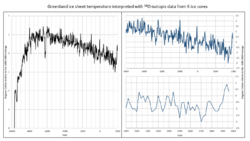Earth:Middle Bronze Age Cold Epoch
From HandWiki
The Middle Bronze Age Cold Epoch was a period of unusually cold climate in the North Atlantic region, lasting from about 1800 BC to about 1500 BC.[1] [2] It was followed by the Bronze Age Optimum (1500—900 BC).
During that epoch, a series of severe volcanic eruptions occurred, including Mount Vesuvius (Avellino eruption, about 1660 BC),[3] Mount Aniakchak (about 1645 BC),[4] and Thera (Minoan eruption, about 1620 BC).[5]
References
- ↑ Siklosy, Z. (2007). "Middle bronze age climate change recorded in a Hungarian stalagmite: triggering by volcanic activity?". Geophysical Research Abstracts 11 (777). http://www.cosis.net/abstracts/EGU2007/00777/EGU2007-J-00777.pdf.
- ↑ VINTHER, B., et al., 2009, “Holocene thinning of the Greenland ice sheet”, Nature, volume 461, (p 385-388). See: https://www.carbonbrief.org/factcheck-what-greenland-ice-cores-say-about-past-and-present-climate-change
- ↑ Vogel, J. S. (1990). "Vesuvius/Avellino, one possible source of seventeenth century BC climatic disturbances". Nature 344 (6266): 534–537. doi:10.1038/344534a0. Bibcode: 1990Natur.344..534V.
- ↑ Pearce, N. J. G., J. A. Westgate, S. J. Preece, W. J. Eastwood, and W. T. Perkins (2004). "Identification of Aniakchak (Alaska) tephra in Greenland ice core challenges the 1645 BC date for Minoan eruption of Santorini". Geochem. Geophys. Geosyst. 5 (3): Q03005. doi:10.1029/2003GC000672. Bibcode: 2004GGG.....5.3005P.
- ↑ Friedrich, Walter L. (2006). "Santorini Eruption Radiocarbon Dated to 1627-1600 B.C.". Science 312 (5773): 548. doi:10.1126/science.1125087. PMID 16645088.
| Preceded by |
Middle Bronze Age Cold Epoch 1800 BC– 1500 BC |
Succeeded by Bronze Age Optimum |


